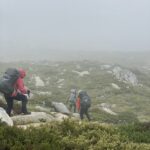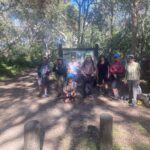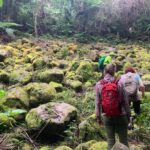The Healing Power of Nature – Byron Hikers
“When you go out there, you don’t get away from it all. You get back to it all. You come home to what’s important. You come home to yourself.”
Peter Dombrovkis
Tasmanian Wilderness Photographer, 1945 – 1996
Human beings have lost our connection to nature – and therefore ourselves. Convenience & consumerism has given us a taste for pleasure at the expense of deeper satisfaction. This has led to psychological issues, widespread environmental destruction and even more disconnection from nature. It’s a vicious circle.
There is significant scientific research that demonstrates the quantifiable, measurable benefits of spending time in nature: a reduction in negative thinking and mental illness, as well of course physical fitness and well-being. Interestingly however, this science often can’t explain why such benefits from spending time in nature have occurred, especially those relating to mental health. It’s very likely that human beings don’t fully understand our relationship to nature. However we know enough to know that it’s vital – literally indispensable to our existence.
The Deakin University Literature Review is a comprehensive review of the science that correlates spending time in nature with measurable mental health benefits. Some quick highlights:
-
“People possess an inherent inclination to affiliate with natural processes and diversity, and this affinity continues to be instrumental in humans’ physical and mental development.” Kellert & Derr 1988
-
“The manifold ways by which human beings are tied to the remainder of life is poorly understood.” Kellert 1993
-
“Scientists have found that merely being in an urban environment impairs our basic mental processes.” Lehrer 2009
-
“The authors concluded that neighbourhood greenness was more associated with mental health than physical health.” Sanesi & Chiarello 2006
-
“When compared with an urban scene and all its attendant features, natural settings with tree views and nature reserves with vegetation and wildlife reduced stress levels and blood pressure while improving mood and lowering anger and aggression in participants.” Laumann 2001
-
“Those closer to natural settings were more able to deal with important matters in their lives and felt more hopeful and less helpless about confronting life issues, whereas those living with minimal green or no green vegetation nearby had the opposite experience.” Kuo 2001
-
“Public housing residents whose nearby natural settings scored higher on the scale showed lower levels of mental fatigue and reported less aggression and violence than residents situated closer to the lower end of the scale.”
-
“Measures of salivary amylase activity (an indicator of sympathetic / stress response nervous system arousal) prior to and following a walk in an urban and forest environment individually, showed that salivary amylase activity of the subjects was reduced in the forest environment relative to the urban environment.” Yamaguchi 2006
-
“Nearly all of the subjects showed higher immune system activity after the three-day forest trip (about a 50 per cent increase) relative to before.” Li 2007






Comments are closed.